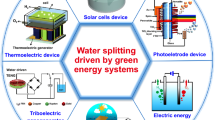Abstract
A powerful approach for studying hydrogenases, applying a suite of dynamic electrochemical techniques known as protein film electrochemistry, is trailblazing fresh discoveries and providing a wealth of quantitative data on these complex enzymes. The information now stemming from experiments on tiny quantities of hydrogenases ranges from their kinetics and catalytic bias (a preference to operate in H2 oxidation vs. H2 production) to wide differences in the ways they react with oxygen and other inhibitors. Tolerance of hydrogenase catalysis to oxygen is essential if organisms are to be exploited for photosynthetic hydrogen production, and is crucial in enabling aerobes to use trace H2 as an energy source. Experiments described in this article may be adapted for other complex enzymes.









Similar content being viewed by others
References
Armstrong FA, Belsey NA, Cracknell JA, Goldet G, Parkin A, Reisner E, Vincent KA, Wait AF (2009) Dynamic electrochemical investigations of hydrogen oxidation and production by enzymes and implications for future technology. Chem Soc Rev 38:38–51. doi:10.1039/b801144n
Cohen J, Kim K, King P, Seibert M, Schulten K (2005) Finding gas diffusion pathways in proteins: application to O2 and H2 transport in Cpl [FeFe]-hydrogenase and the role of packing defects. Structure 13:1321–1329. doi:10.1016/j.str.2005.05.013
Cracknell JA, Vincent KA, Ludwig M, Lenz O, Friedrich B, Armstrong FA (2008) Enzymatic oxidation of H2 in atmospheric O2: the electrochemistry of energy generation from trace H2 by aerobic microorganisms. J Am Chem Soc 130:424–425. doi:10.1021/ja078299+
Fontecilla-Camps JC, Volbeda A, Cavazza C, Nicolet Y (2007) Structure/function relationships of [NiFe]- and [FeFe]-hydrogenases. Chem Rev 107:4273–4303. doi:10.1021/cr050195z
Ghirardi ML, Posewitz MC, Maness PC, Dubini A, Yu J, Seibert M (2007) Hydrogenases and hydrogen photoproduction in oxygenic photosynthetic organisms. Annu Rev Plant Biol 58:71–91. doi:10.1146/annurev.arplant.58.032806.103848
Goldet G, Wait AF, Cracknell JA, Vincent KA, Ludwig M, Lenz O, Friedrich B, Armstrong FA (2008) Hydrogen production under aerobic conditions by membrane-bound hydrogenases from Ralstonia species. J Am Chem Soc 130:11106–11113. doi:10.1021/ja8027668
Hambourger M, Gervaldo M, Svedruzic D, King PW, Gust D, Ghirardi M, Moore AL, Moore TA (2008) [FeFe]-hydrogenase-catalyzed H2 production in a photoelectrochemical biofuel cell. J Am Chem Soc 130:2015–2022. doi:10.1021/ja077691k
Jones AK, Sillery E, Albracht SPJ, Armstrong FA (2002) Direct comparison of the electrocatalytic oxidation of hydrogen by an enzyme and a platinum catalyst. Chem Commun 866–867. doi:10.1039/b201337a
Lamle SE, Albracht SP, Armstrong FA (2004) Electrochemical potential-step investigations of the aerobic interconversions of [NiFe]-hydrogenase from Allochromatium vinosum: new insights into the puzzling difference between unready and ready oxidized inactive states. J Am Chem Soc 126:14899–14909. doi:10.1021/ja047939v
Lamle SE, Albracht SP, Armstrong FA (2005) The mechanism of activation of a [NiFe]-hydrogenase by electrons, hydrogen and carbon monoxide. J Am Chem Soc 127:6595–6604. doi:10.1021/ja0424934
Léger C, Bertrand P (2008) Direct electrochemistry of redox enzymes as a tool for mechanistic studies. Chem Rev 108:2379–2438. doi:10.1021/cr0680742
Léger C, Dementin S, Bertrand P, Rousset M, Guigliarelli B (2004) Inhibition and aerobic inactivation kinetics of Desulfovibrio fructosovorans NiFe hydrogenase studied by protein film voltammetry. J Am Chem Soc 126:12162–12172. doi:10.1021/ja046548d
Lubitz W, Reijerse EJ, Messinger J (2008) Solar water-splitting into H2 and O2: design principles of photosystem II and hydrogenases. Energ Environ Sci 1:15–31. doi:10.1039/b808792j
Ludwig M, Cracknell JA, Vincent KA, Armstrong FA, Lenz O (2008) Oxygen-tolerant H2 oxidation by membrane-bound [NiFe] hydrogenases of Ralstonia species: coping with low-level H2 in air. J Biol Chem 284:465–477. doi:10.1074/jbc.M803676200
Nicolet Y, Piras C, Legrand P, Hatchikian CE, Fontecilla-Camps JC (1999) Desulfovibrio desulfuricans iron hydrogenase: the structure shows unusual coordination to an active site Fe binuclear center. Structure 7:13–23. doi:10.1016/S0969-2126(99)80005-7
Ogata H, Hirota S, Nakahara A, Komori H, Shibata N, Kato T, Kano K, Higuchi Y (2005) Activation process of [NiFe] hydrogenase elucidated by high-resolution X-ray analyses: conversion of the ready to the unready state. Structure 13:1635–1642. doi:10.1016/j.str.2005.07.018
Parkin A, Cavazza C, Fontecilla-Camps JC, Armstrong FA (2006) Electrochemical investigations of the interconversions between catalytic and inhibited states of the [FeFe]-hydrogenase from Desulfovibrio desulfuricans. J Am Chem Soc 128:16808–16815. doi:10.1021/ja064425i
Parkin A, Goldet G, Cavazza C, Fontecilla-Camps JC, Armstrong FA (2008) The difference a Se makes? Oxygen-tolerant hydrogen production by the [NiFeSe]-hydrogenase from Desulfomicrobium baculatum. J Am Chem Soc 130:13410–13416. doi:10.1021/ja803657d
Reisner E, Fontecilla-Camps JC, Armstrong FA (2009) Catalytic electrochemistry of a [NiFeSe]-hydrogenase on TiO2 and demonstration of its suitability for visible-light driven H2 production. Chem Commun 550–552
Vignais PM, Billoud B (2007) Occurrence, classification, and biological function of hydrogenases: an overview. Chem Rev 107:4206–4272. doi:10.1021/cr050196r
Vincent KA, Parkin A, Lenz O, Albracht SP, Fontecilla-Camps JC, Cammack R, Friedrich B, Armstrong FA (2005) Electrochemical definitions of O2 sensitivity and oxidative inactivation in hydrogenases. J Am Chem Soc 127:18179–18189. doi:10.1021/ja055160v
Vincent KA, Cracknell JA, Clark JR, Ludwig M, Lenz O, Friedrich B, Armstrong FA (2006) Electricity from low-level H2 in still air—an ultimate test for an oxygen tolerant hydrogenase. Chem Commun 5033–5035
Vincent KA, Parkin A, Armstrong FA (2007) Investigating and exploiting the electrocatalytic properties of hydrogenases. Chem Rev 107:4366–4413. doi:10.1021/cr050191u
Volbeda A, Martin L, Cavazza C, Matho M, Faber BW, Roseboom W, Albracht SP, Garcin E, Rousset M, Fontecilla-Camps JC (2005) Structural differences between the ready and unready oxidized states of [NiFe] hydrogenases. J Biol Inorg Chem 10:239–249. doi:10.1007/s00775-005-0632-x
Acknowledgments
Research on hydrogenases in the author’s laboratory has been supported by the UK BBSRC and EPSRC.
Author information
Authors and Affiliations
Corresponding author
Rights and permissions
About this article
Cite this article
Armstrong, F.A. Dynamic electrochemical experiments on hydrogenases. Photosynth Res 102, 541–550 (2009). https://doi.org/10.1007/s11120-009-9428-0
Received:
Accepted:
Published:
Issue Date:
DOI: https://doi.org/10.1007/s11120-009-9428-0




